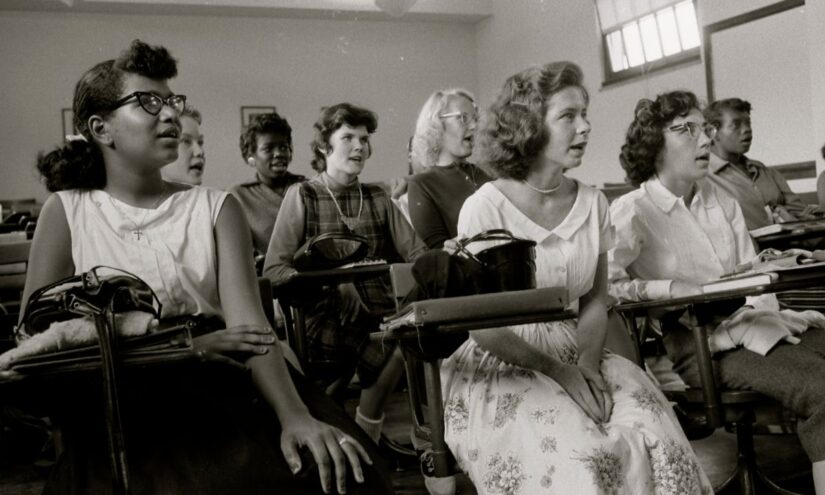During this summer, a team of students from MIT embarked on a journey to the sou …
School segregation has increased over the past 30 years.
Jennifer Livingstone

Researchers studying racial isolation in classrooms have noted an increase over the past thirty years, primarily in America’s largest school districts. This rise in segregation has occurred due to the expansion of school choice and the decline of court-ordered desegregation mandates, leading to a greater racial divide between white and non-white students.
A study coinciding with the 70th anniversary of the historic Brown v. Board of Education ruling highlighted the peak of integration in the 1980s, followed by a gradual decline since then. The research raises concerns about the extent of this regression on a national scale and posits potential solutions to address the issue.
Interestingly, the trend towards racial isolation persists despite the increasing proximity of different racial and ethnic groups in American society. Professor Ann Owens, co-author of the analysis from the University of Southern California, pointed out how public policy measures are contributing to the reversal of the decline in residential segregation.
Owens stated, “While school segregation tends to be higher in areas with greater residential segregation, this alone cannot explain the increase witnessed over the past three decades, as residential segregation has not been on the rise during this period.”
The latest study by Owens and Stanford professor Sean Reardon, which has not been released publicly yet, was presented at a Stanford conference in early May. They also introduced the Segregation Explorer, an interactive tool for examining segregation patterns across schools, districts, cities, and counties.
It’s also true that white kids attend school with fewer white kids — because there are fewer white kids around.
Ann Owens, University of Southern California
Utilizing data from the National Center for Education Statistics, the analysis assesses the exposure of students to peers of different racial backgrounds. By comparing the racial composition of the average African American student’s classmates and the average white student’s classmates in a district, a “segregation level” is determined on a scale of 0–1.
Studies have shown that after substantial drops following federal integration efforts in the 1960s and ’70s, school segregation began to resurface in the late 1980s. Owens and Reardon found that between 1991 and 2019, segregation levels increased by over one-third in 541 U.S. school districts enrolling at least 2,500 African American students.

However, Owens cautioned that in the broader historical context, schools today are more racially diverse compared to the pre-Brown era. The overall rise in segregation levels has been marginal, increasing by less than five percentage points since the time of George H.W. Bush’s administration.
I don’t know if I would look at the trend from 1990 to 2020 and characterize that as ‘resegregation.’
Brian Kisida, University of Missouri
Economist Brian Kisida stressed the importance of tracking changes in cross-racial exposure over time. While acknowledging the significance of segregation as a persistent societal concern, Kisida refrained from labeling the trend from 1990 to 2020 as outright ‘resegregation.’
He further emphasized that the research’s findings on charter schools exacerbating racial segregation align with his own previous work, indicating a notable impact on the racial balance of districts. A study he co-authored in 2019 revealed that abolishing the charter sector could reduce the segregation of Hispanic and African American students by 5 percent, although charters also attracted students to more integrated settings across districts.
…
The charter factor
Moreover, Kisida highlighted the new study’s estimation that segregation growth would have decreased by two to three percentage points had charter school expansion post-2000 been curbed.
Another attributed factor to the decline in integration was the gradual fading of desegregation orders commencing in the 1990s. As federal courts released districts from mandates to balance racial groups among schools, campuses became slightly more segregated, indicating the impact of policy shifts.
Shep Melnick from Boston College, an expert on desegregation efforts post-Brown, underscored how the lifting of injunctions escalated in the early 2000s, impacting over half of the districts under court oversight. He noted cases where local enforcement of these orders lacked awareness, suggesting limited effects upon their expiration.
Some of these schools that were formerly under court order didn’t even realize they were under court order. So the effects of the orders in those cases probably were not that great.
Shep Melnick, Boston College
Melnick and Owens emphasized the importance of understanding the varied dimensions of racial segregation in research, especially considering the transforming demographics due to increased diversity. Efforts to tackle desegregation challenges should encompass the changing student population dynamics over time.
Owens concluded, “When you say, ‘Black students attend school with fewer white kids than they did 50 or 60 years ago,’ that’s true. But it’s also true that white kids attend school with fewer white kids — because there are fewer white kids around.”



